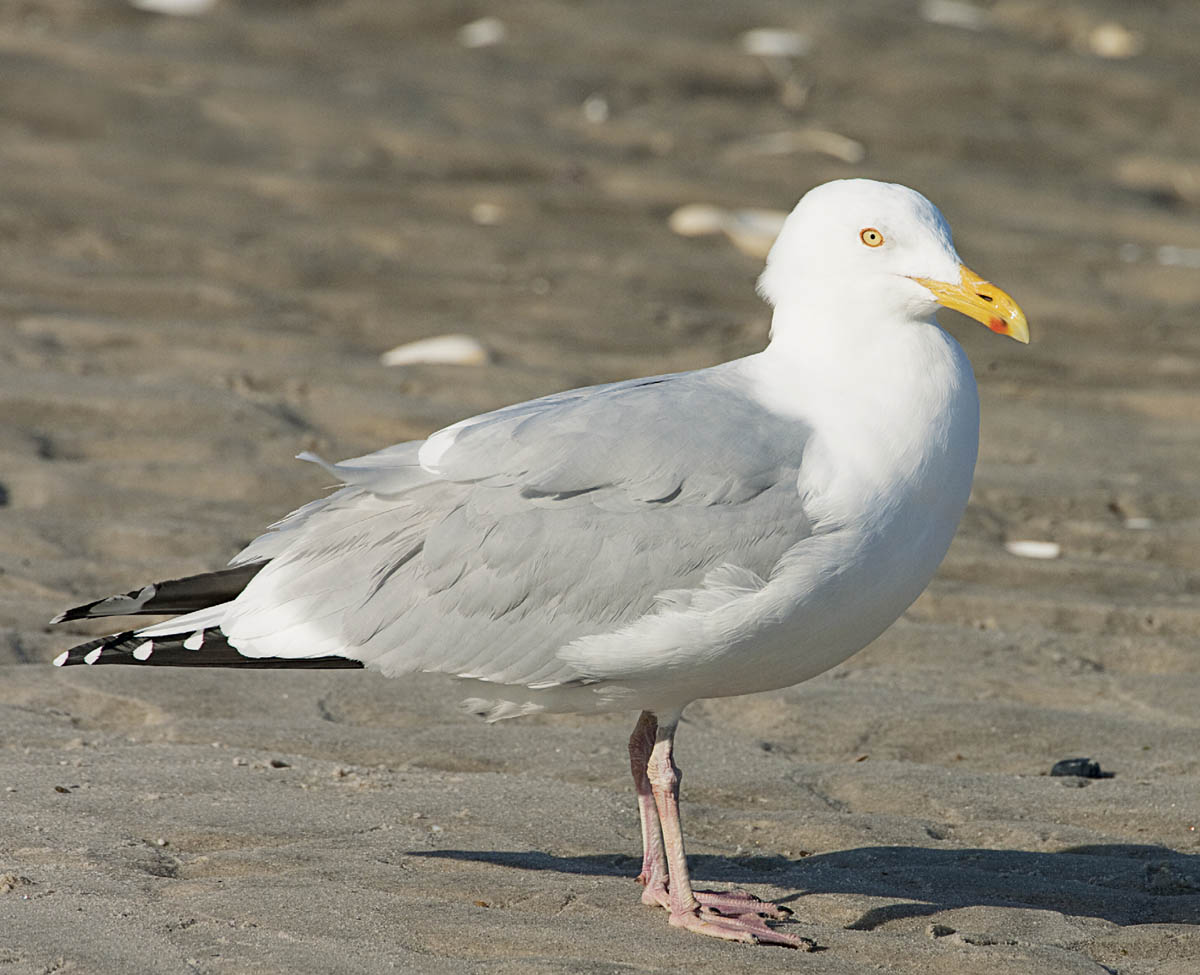
Herring Gull adult
One of the larger gull species, Herring Gulls are the most common breeding gull in the northeastern United States and much of Canada. Eating mostly fish and other aquatic creatures, they are famous for dropping crabs, clams, and other food items that are too large to be swallowed whole onto rocks or hard surfaces to break them open.

Herring Gull adult
Like other gulls, Herring Gulls spend a lot of time at dumps and landfills, but most use the sites more for roosting, socializing, and just loafing around than for dining. Sociable throughout the year, during the non-breeding seasons, gulls gather in huge flocks wherever food is easy to find.
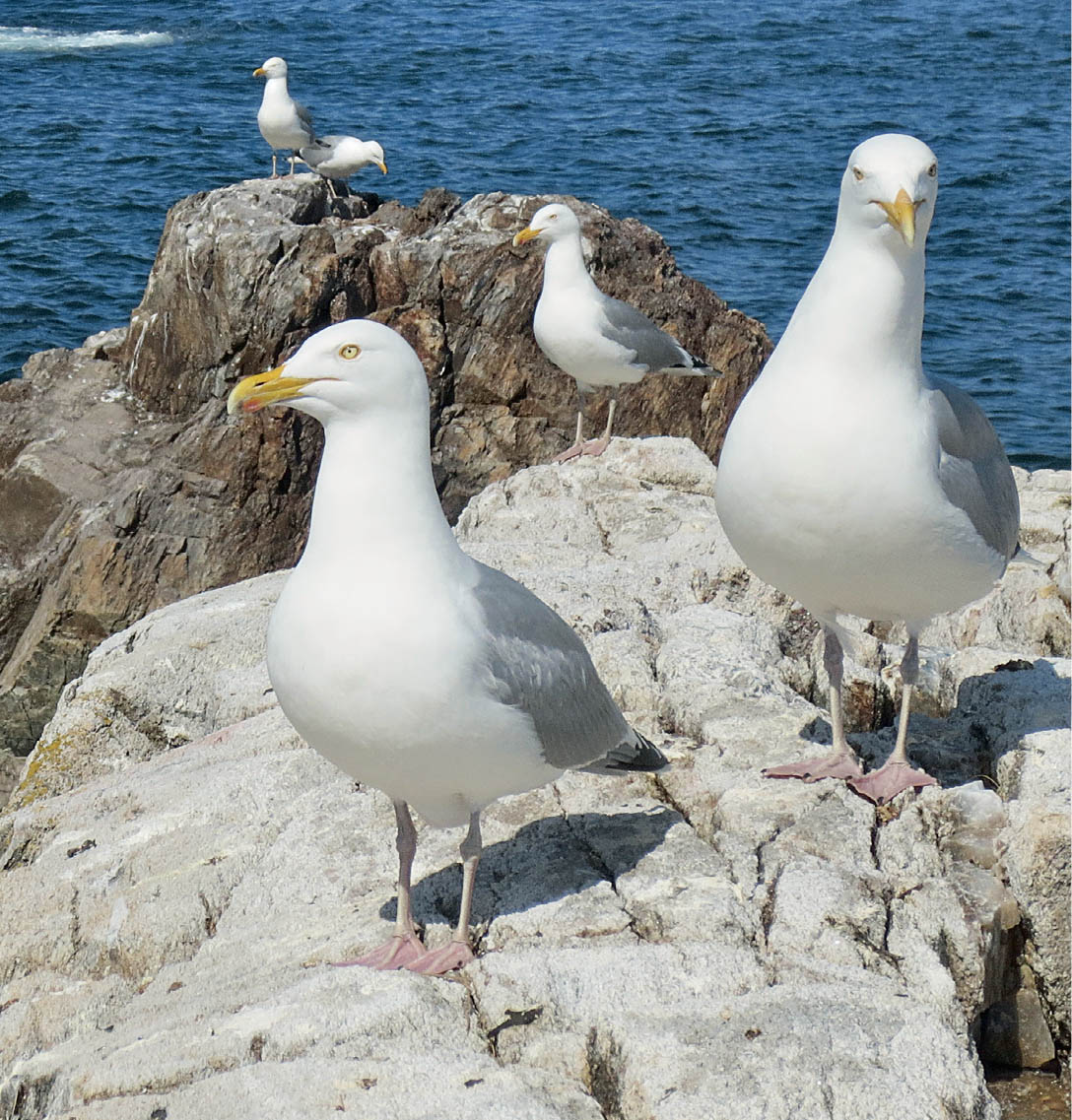
Herring Gulls usually nest in large colonies that may include other gull species, terns, skimmers, and some diving seabirds. They prefer to breed on isolated islands inaccessible to terrestrial predators, either in coastal marine areas or in large freshwater lakes in the far north. Some nest in coastal cities, often on rooftops near water.
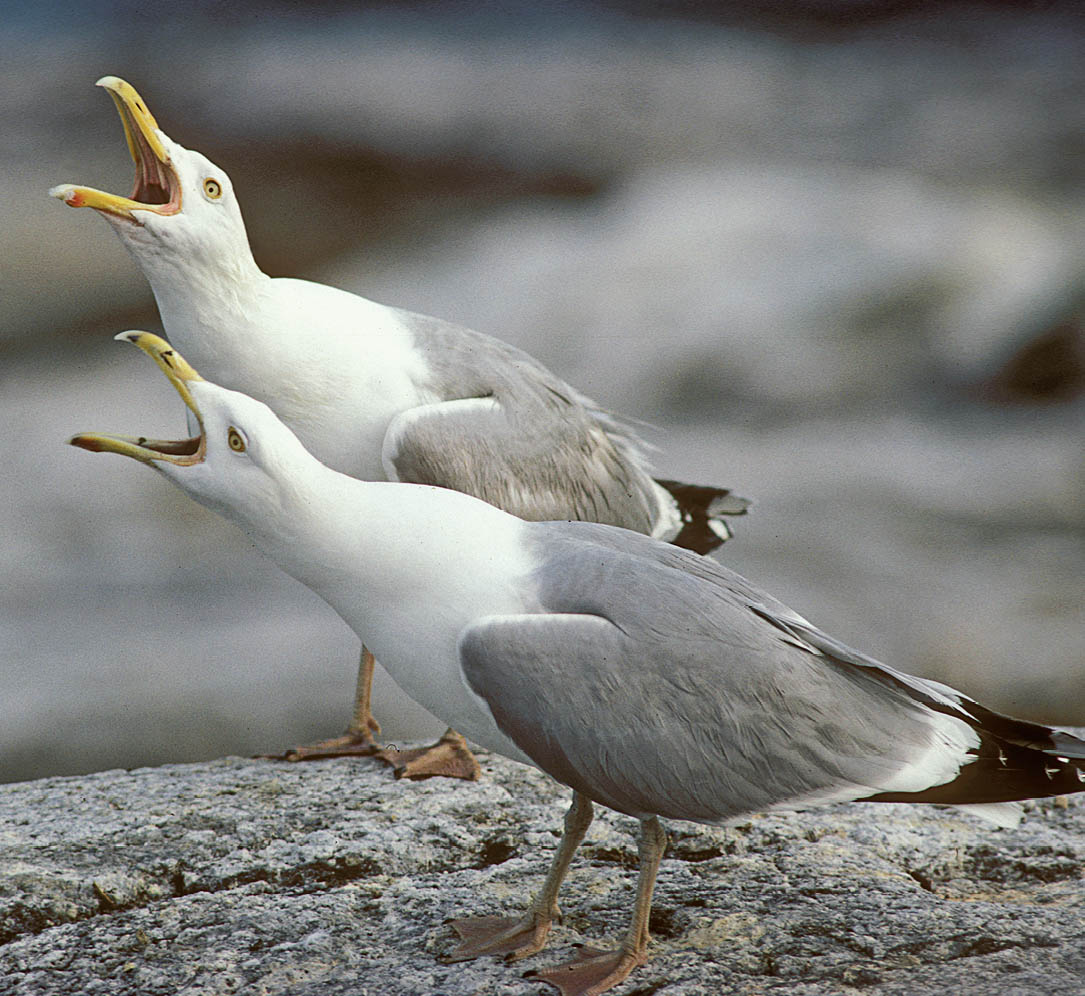
From the rocks above their nest site, paired Herring Gulls give the long call. This familiar “seagull” sound is made after territorial boundary disputes, to threaten rivals, in response to neighbors flying over the territory, and by one bird when its mate returns from absence.
As the breeding season approaches, each unattached male gravitates to an established colony to seek a small, undefended territory where he can nest. Then he must attract a female who will select and defend the nest site within the territory with him. Previously mated pairs return to the previous year’s nest site.
Courtship is simple and to the point. The female approaches the male, begging for food and tossing her head, and he regurgitates food for her. Her acceptance of the food may immediately trigger copulation. Courtship feeding not only seals their pair bond but also supplements her nutrition while her body is producing eggs. The pair defend the territory together with threatening postures and strident calls, which may escalate into chases and fights with rivals on the ground and in midair.
Herring Gulls often build their nest next to a rock, log, or bush, probably for protection from both the wind and predators. The pair create a few scrapes on the ground and may fill them with bits of vegetation. When a scrape seems ready, the builder performs a choke display, lowering its head and jerking it rhythmically while swelling its throat making a deep huoh-huoh-huoh call. When the other finds it acceptable, it joins in the display, and that becomes the scrape where the female will lay her eggs.
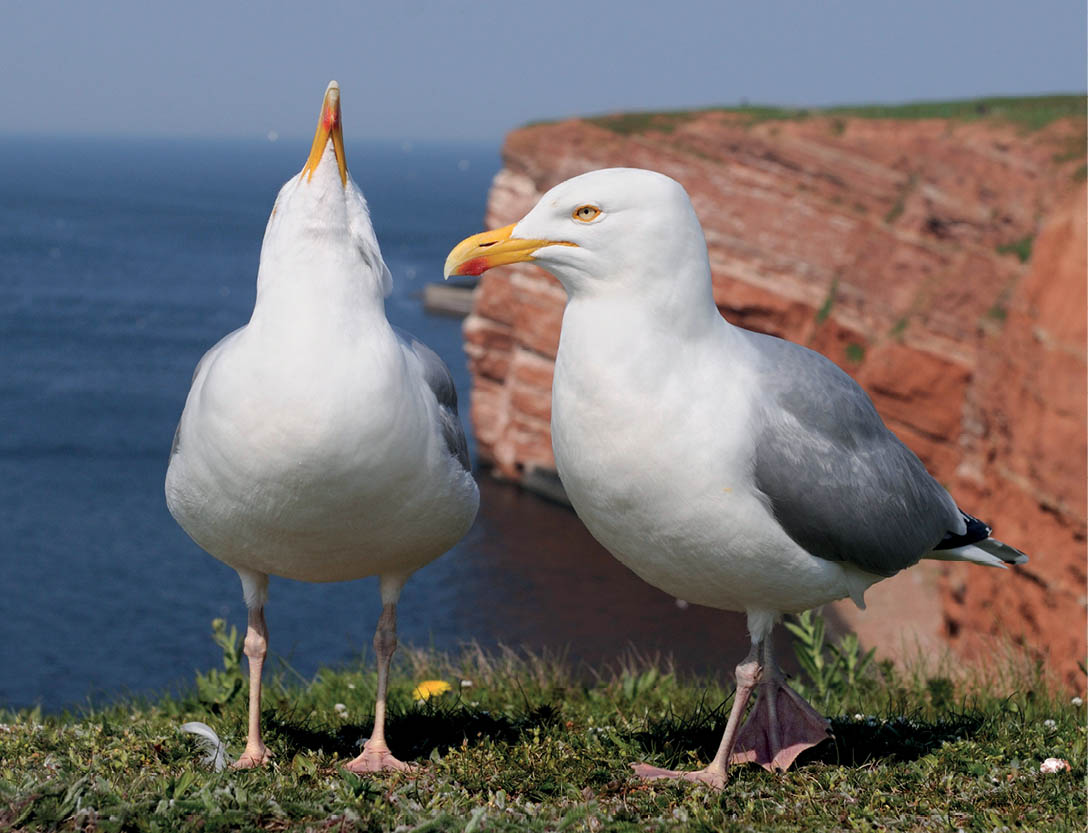
Before egg-laying begins, the female Herring Gull often begs from her mate, approaching him in a hunched posture and repeatedly flicking her head upward, giving a plaintive klee-ew with each flick. The male then feeds her. This supplementary feeding may help her during egg formation.
The female lays her first egg early one morning once the nest is fairly complete, but the pair may continue adding grasses, feathers, plastic, rope, and other strand-like material throughout incubation. She lays the second egg (often the heaviest in the clutch) two days later, and the third (usually the smallest) two days after that.
Both parents share incubation duties equally, starting when the first egg is laid. Each develops three brood patches, but at first the feathers haven’t all dropped and the skin isn’t yet vascularized (it lacks the network of blood vessels necessary to transfer body heat). So the first two eggs start developing at about the same time and generally hatch at about the same time, about 30 days after the first egg was laid.
Herring Gull pairs have a strong pair bond. If one parent dies during nesting, it’s almost impossible for the other to raise the young successfully, because without one or the other adult present at all times, predators (including other gulls) may kill unattended eggs and chicks.
Once a pair is established, especially if they raise young successfully, they remain together as long as they both survive. It’s not certain whether they stay together over the non-breeding months or take separate vacations, but the “divorce rate” in Herring Gulls is very low. Of more than 300 pairs of Herring Gulls observed during a long-term study, only eight pairs broke up while both were still alive.
The third chick, hatching a day or two later, obtains less food and grows more slowly than the other two and is more likely to die when food isn’t adequate. If the smallest isn’t getting enough food, it may wander off its parents’ territory. In about 30 to 40 percent of these cases, however, another pair will “adopt” that chick and care for it.
Gull chicks are semi-precocial: they hatch covered with thick down and with their eyes open. They can move about much more freely than altricial chicks but aren’t nearly as mobile as precocial chicks. They must rely on their parents for food. After the first few hours chicks may wander near the nest, and within a week, they can run about their parents’ territory freely.
The parents find or catch food and eat it away from the territory, and also offer regurgitated blobs to the chicks at the nest. Eventually the chicks manage some entire fish and other items, including refuse. Chicks that are fed garbage grow more slowly and have greater mortality than those fed natural diets.
Incubating. An adult Herring Gull incubates on its nest in a rock crevice. Incubation lasts 31 to 32 days; both parents share duties, although the female usually incubates overnight.
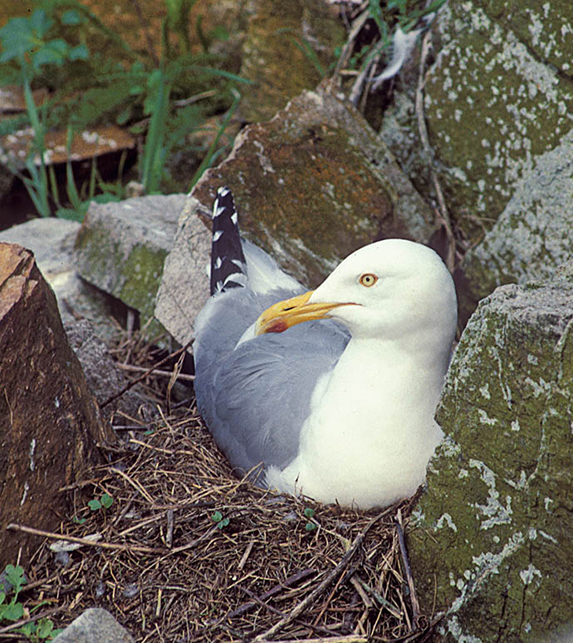
Near Hatching. A grass-lined Herring Gull nest with three eggs, numbered by scientists to identify the order in which they were laid. Studies such as this have established that the first two eggs hatch on the same day, the third usually a couple of days later.
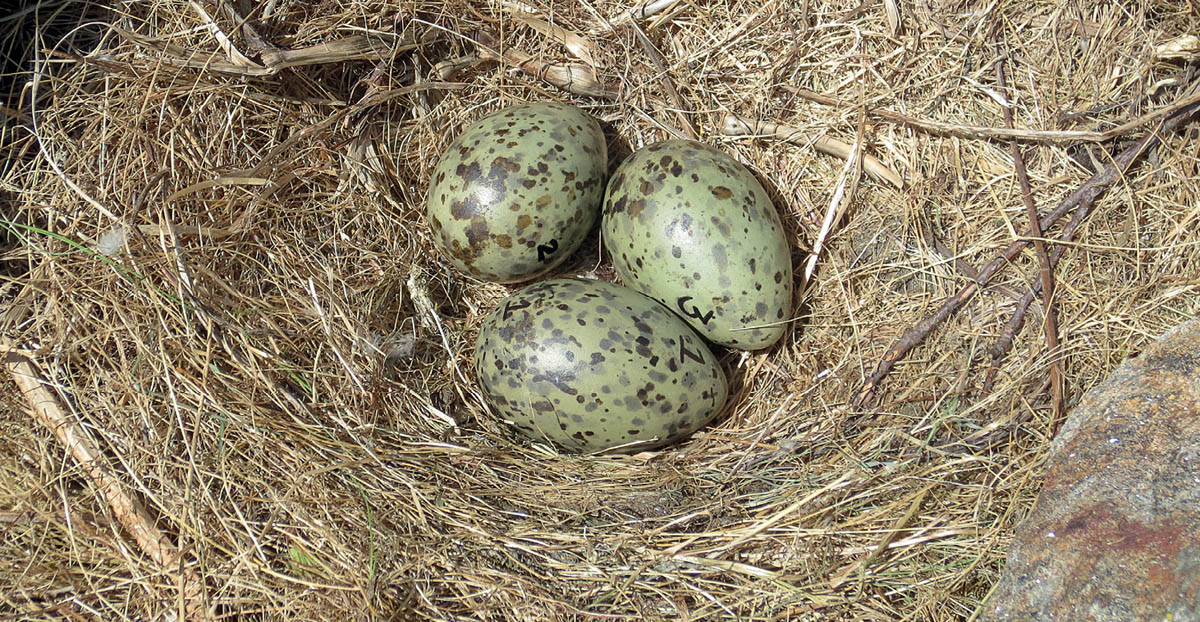
Pipping. The tiny beak of a hatching Herring Gull, with the white egg tooth at the tip, emerges from the egg. It may take two days for the chick to create that pipped hole after the first tiny cracks in the shell are visible.
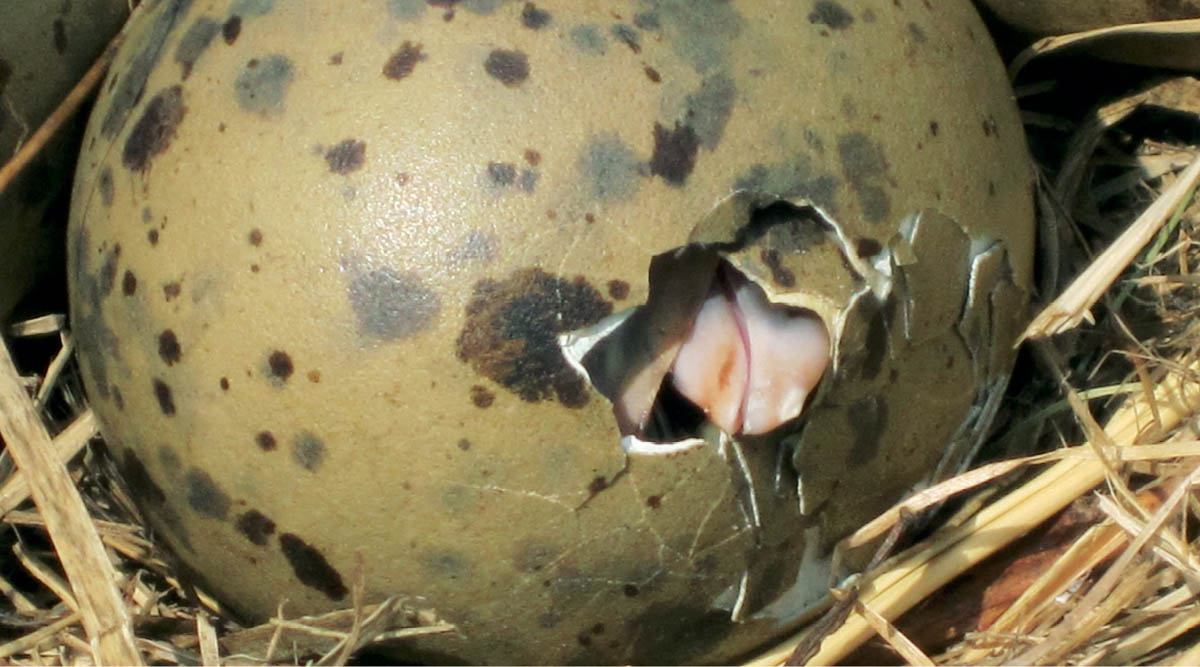
Hatching. The eggshell at the top of the photo has finally broken and the chick, wet and exhausted, has pushed its way out using its feet. Meanwhile, the second egg (lower right) is pipped and another chick will soon emerge. The third egg should hatch in two days or so.
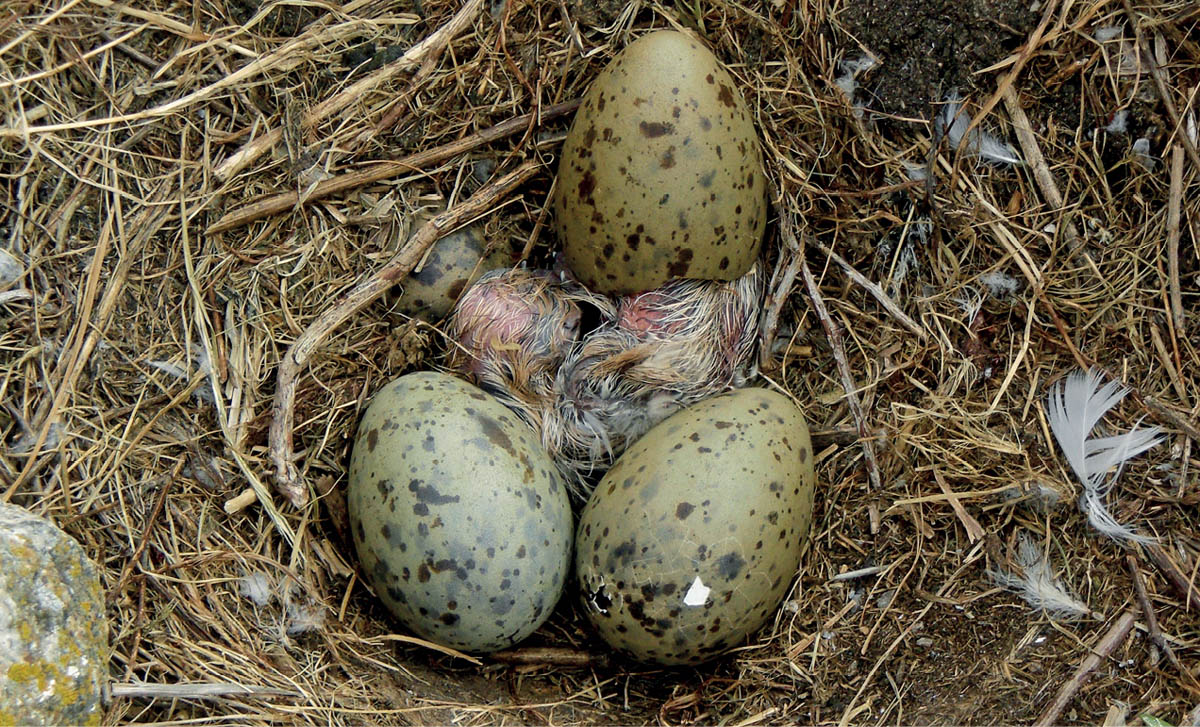
Resting. The first chick is dry, and a second chick’s bill (with egg tooth) is visible through the pip in its egg. The parents watch over the hatching chicks but give no assistance, although they may remove the empty eggshells from the nest.
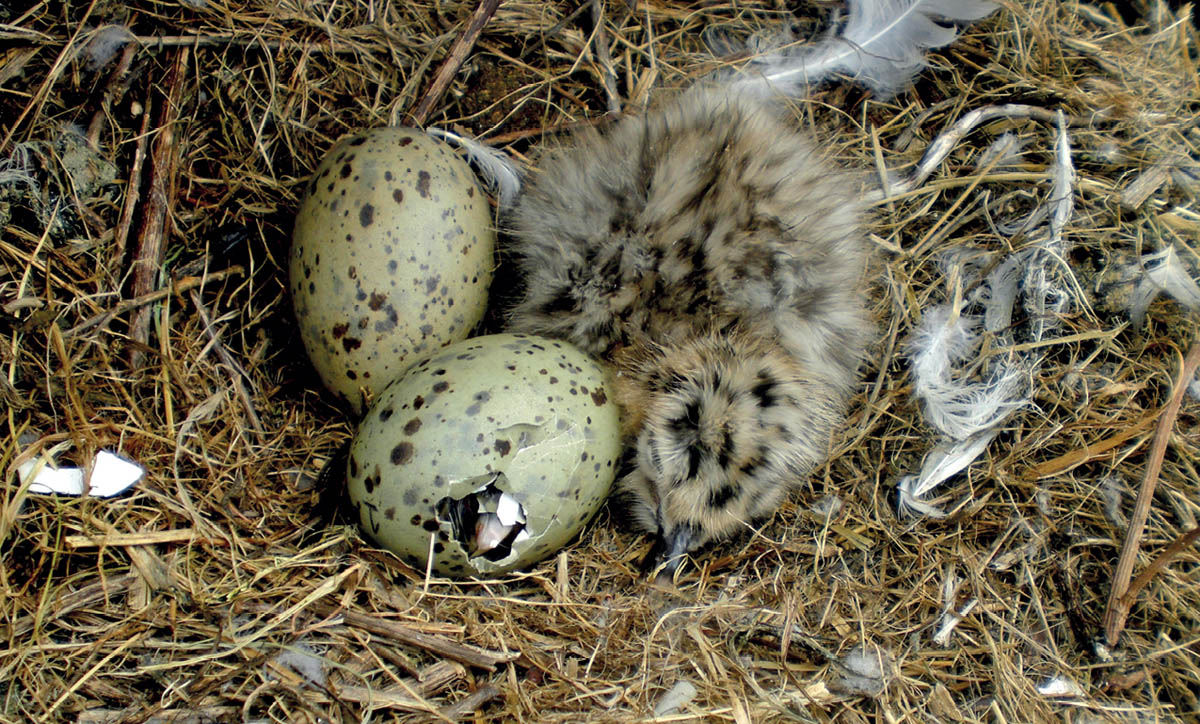
Feeding. Less than 10 days old, a Herring Gull chick begs for food by pecking at the red spot on the lower mandible of its parent’s bill. This may stimulate the adult to regurgitate food, or it may help younger chicks orient themselves during feeding.
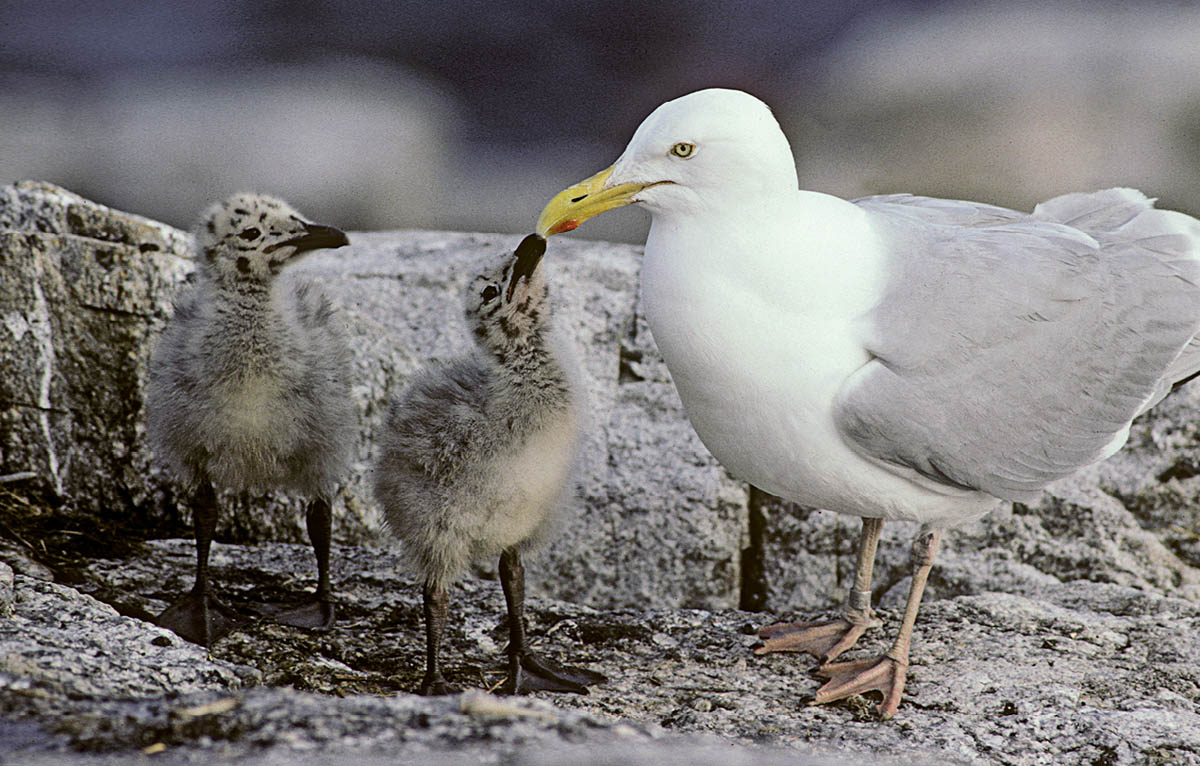
Foraging. Herring Gull chicks at 20–25 days. By this age they have partially developed wing feathers, as well as fully feathered backs and underparts, but their heads retain the natal down and their tail feathers are barely beginning to emerge. Green leg bands identify these individuals as part of a research population.
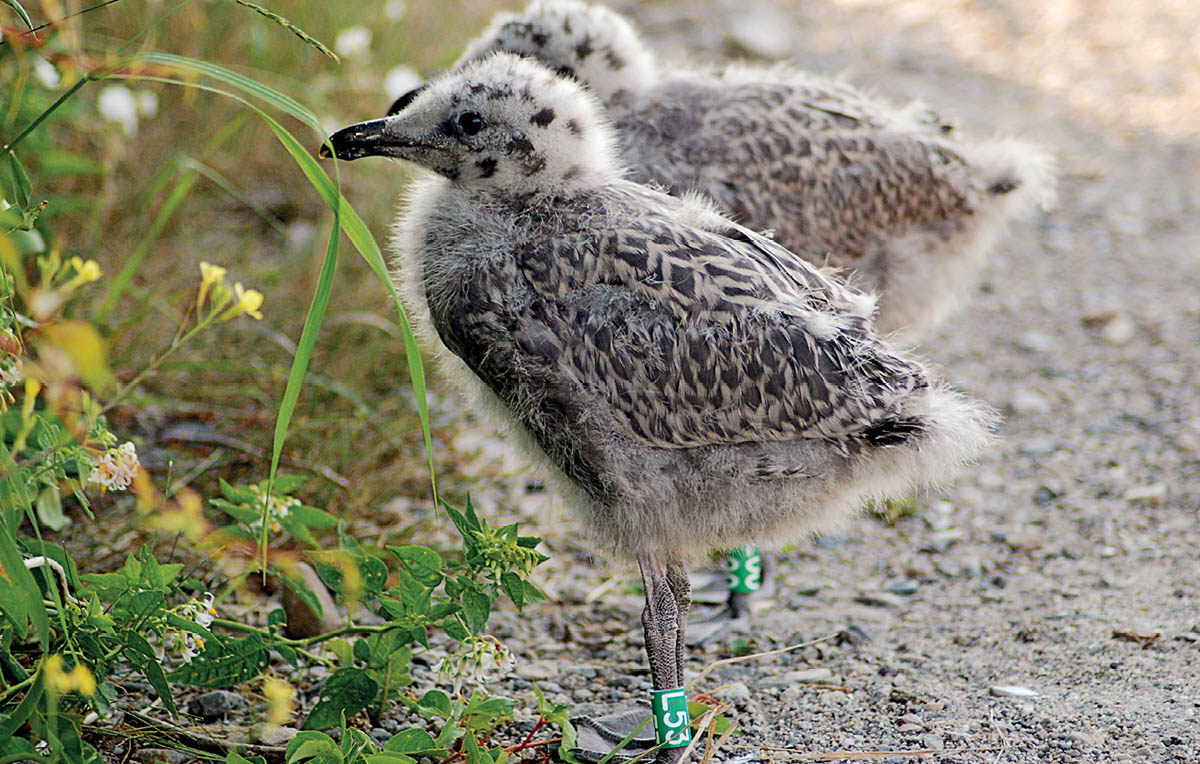
Herring Gull chicks leave the nesting territory on their first flight at about 45 to 50 days. At this point, their bodies are fully grown and they’re usually heavier than their parents, though their wings and tail feathers aren’t their full length yet. Some of these chicks may continue to associate with and beg from their parents for up to six months more, while others end up in groups with other young birds.
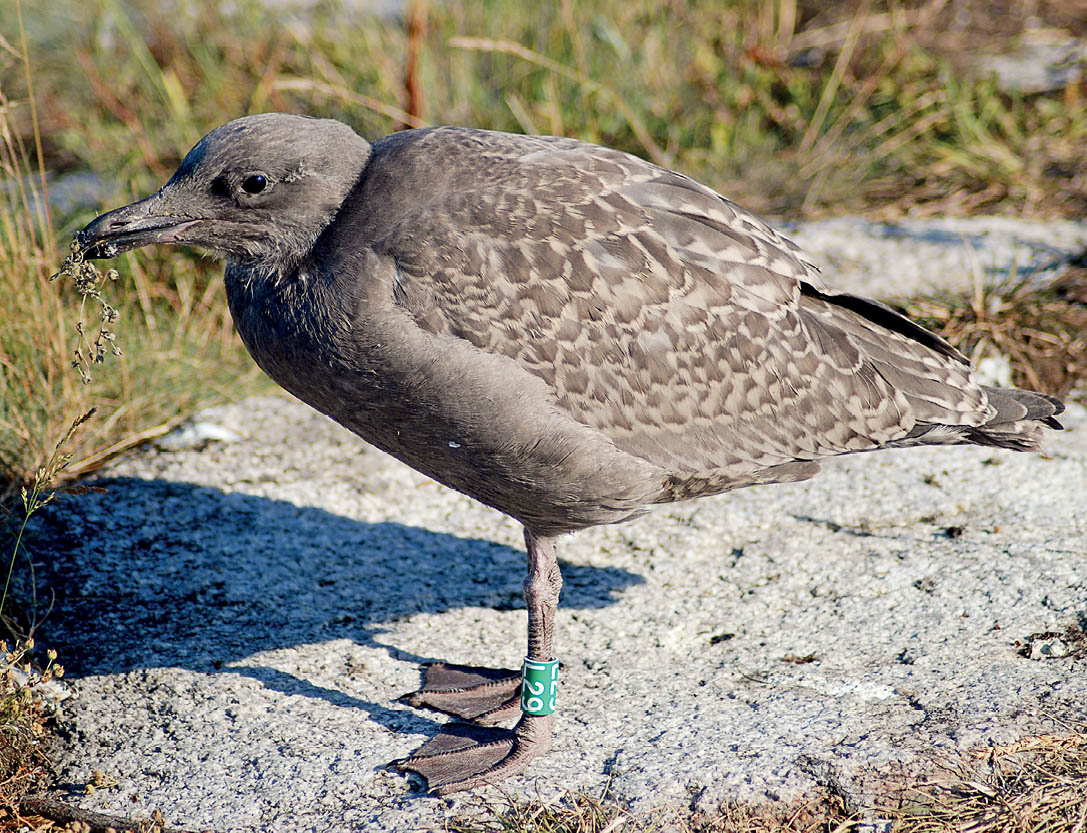
At about 40 to 50 days of age, this young Herring Gull, covered with mottled brown plumage, is called a juvenile. For the next four years, each time it molts, its plumage will have a larger proportion of gray and white feathers until it attains adult breeding plumage.

A Herring Gull chick takes its first flight when it’s 45 to 50 days old, but may continue to return to its parents’ territory to be fed until 12 to 15 weeks of age. Until it learns to forage for itself, it may lose weight. Juveniles gather in groups around the colony, and also concentrate in areas where food is easier to find.